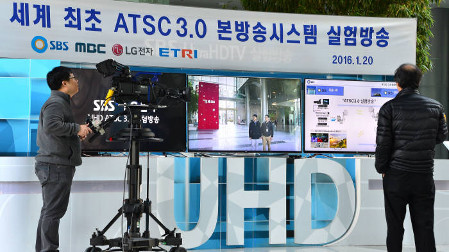SEOUL—Several Korean broadcasters announced this week that they will begin transmitting ATSC 3.0 OTA broadcasts starting in February 2017. The news comes after the two broadcast networks, SBS and MBC—in conjunction with LG Electronics, ETRI and several equipment vendors—announced the first successful live end-to-end ATSC 3.0 broadcast in the country, and represents perhaps the best confirmation yet that the ATSC 3.0 next generation broadcast standard is on schedule to be completed within the next 12 months.

Real-World 4K Broadcast Demonstrates ATSC 3.0 Global Collaboration with Ultra HD Broadcast Service Scheduled to Begin in Korea Next February. (Photo Credit: LG Electronics)
The first end-to-end broadcast of 4K Ultra HD represents a significant development, according to LG, because past demonstrations (including several Futurecast tests conducted in the U.S. in 2014 and 2015) have simply used pre-recorded material loaded directly to a transmitter. This test broadcast featured a live camera feed with real-time IP transmissions from the SBS network studio (one of the two in Mokdong to the broadcaster’s Gwanak Mountain transmitter. The IP signals transmitted over the air on Channel 53 were then received using a simple antenna and decoded by a 4K Ultra HDTV ATSC 3.0 receiver developed by LG Electronics. Signals in the Korean broadcast were delivered with next-generation IP technologies based on the DASH (Dynamic Adaptive Streaming over HTTP) streaming media format and ROUTE (Real-Time Object Delivery Over Unidirectional Transport) IP delivery protocol.
SBS coordinated a combination of broadcast equipment and systems, including the 4K video server, ROUTE-based HEVC (High Efficiency Video Coding) encoder, ROUTE-based multiplexer, signaling server, and ATSC 3.0 management system, all of which were used for the broadcasting demonstration. MBC participated in the broadcast transmission interface and reception measurement testing. DigiCap provided the ATSC 3.0 signaling server, and Media Excel provided the HEVC real-time encoder.
Being developed as a global standard by the U.S.-based Advanced Television Systems Committee, the ATSC 3.0 standard is being touted as the world’s first Internet Protocol (IP)-based broadcast system, combining broadcasting the broadband for the first time. Most of the 20 elements that comprise the ATSC standard have now moved to Candidate Standard status, one of the last steps in the standardization process.
ATSC is the broadcast standard for a half dozen countries in North America, including Canada and Mexico and South Korea’s ETRI has been viewed as a leader in the development of ATSC 3.0. There have been numerous tests of the ATSC 3.0 standard conducted in the United States, including the aforementioned Futurecast, as well as tests from Sinclair Broadcast Group with Technicolor in 2014 and 2015and the 2016 CES, which focused on transmitting 4K HDR content. An LG spokesman noted that the Futurecast tests conducted last year were designed to “show the relative performance of LG technology as proposed for the Physical Layer,” he said. “In the end, several elements from LG were incorporated in the Physical Layer that is now elevated to Candidate Standard status.”
Korean-based Samsung, the world’s largest consumer electronics manufacturer, has also been involved in developing and testing the ATSC 3.0 standard, teaming up with Sinclair and start-up ONE Media for several over-the-air tests over the past year.
Dr. Young-Soo Park, SBS technical director, said, “The success of this trial highlights the potential for Korea’s launch of terrestrial UHD TV commercial services using ATSC 3.0 in February 2017. And the fact that Korean companies are playing such an important role in ATSC 3.0 provides a good opportunity for Korean equipment manufacturers to advance in the U.S. market.”
Following the success of the experimental broadcast, SBS and MBC said they plan to work with LG and ETRI (the Electronics and Telecommunications Research Institute) of Korea to take full advantage of new capabilities of ATSC 3.0, such as the combination of broadcast and broadband signals. “We will continue to develop technologies to help commercialize ATSC 3.0 as the next great advance in terrestrial broadcasting,” said Dr. K.Y. Kwak, executive vice president, LG’s Advanced Standard Research & Development Lab.
The professional video industry's #1 source for news, trends and product and tech information. Sign up below.
Also see:
Jan. 6, 2016
"KHMP-LD Delivers Live HDR 4KTV in ATSC 3.0 at CES"
LG is reporting that KHMP-LD is live broadcasting 4K Ultra HDTV with high dynamic range using the new ATSC 3.0 Candidate Standard at CES 2016.
Dec. 3, 2015
"Sinclair Demos HDR 4KTV Over ATSC 3.0 in Vegas"
Sinclair Broadcast Group, along with subsidiary One Media and Technicolor, report they have successfully transmitted high-dynamic range 4KTV over the air using the proposed ATSC 3.0 standard and a prototype reception device.
Nov. 17, 2015
“ATSC 3.0 DTV Standard Gets Far East ‘Test Drive'”
History was made here last month as a multinational group of television engineers gathered to perform systems compatibility testing of the ATSC 3.0 digital TV standard. The event, officially dubbed “Plug Fest 2015,” was hosted by China’s National Engineering Research Center of Digital Television, Oct. 19-23.
Oct. 18. 2014
"Sinclair and Technicolor Do ATSC 3.0 4K Over-the-Air Broadcast"
Sinclair Broadcast Group and Technicolor said they successfully deployed Technicolor’s ATSC 3.0 4K UltraHD testbed platform and receiving an over-the-air signal.
July 13, 2015
"Inside the Cleveland Futurecast ATSC 3.0 Transmission Tests"
Work on a future ATSC 3.0 standard is moving swiftly, with officials from GatesAir, LG and Zenith’s research and development lab predicting that there will be a “candidate standard” by the end of this year.
Jan. 12, 2016
"ATSC 3.0 Brings Flexibility of IP to Broadcast"
The hardest part of the ATSC 3.0 proposed broadcast standard to get one’s head around is probably the IP transport piece. Over-the-air TV, as it stands, might have its distribution network issues, but they pale when compared to the Internet’s limitations.
May 28. 2015
"Why Move to ATSC 3.0?"
Why move to ATSC 3.0? There are many answers to that question, and the hundreds of people who attended the annual ATSC Broadcast Television Conference and ATSC 3.0 Boot Camp earlier this month came away with new insights about how broadcasters will reach tomorrow’s audience hungry for local news, emergency alerts, favorite shows, and a seamless experience that merges broadcasting with the Internet.
Tom has covered the broadcast technology market for the past 25 years, including three years handling member communications for the National Association of Broadcasters followed by a year as editor of Video Technology News and DTV Business executive newsletters for Phillips Publishing. In 1999 he launched digitalbroadcasting.com for internet B2B portal Verticalnet. He is also a charter member of the CTA's Academy of Digital TV Pioneers. Since 2001, he has been editor-in-chief of TV Tech (www.tvtech.com), the leading source of news and information on broadcast and related media technology and is a frequent contributor and moderator to the brand’s Tech Leadership events.

